Malagasy coucal facts for kids
Quick facts for kids Malagasy coucal |
|
|---|---|
 |
|
| At Ankarafantsika, Madagascar | |
| Conservation status | |
| Scientific classification | |
| Genus: |
Centropus
|
| Species: |
toulou
|
The Malagasy coucal, also called the Madagascar coucal, is a type of cuckoo bird. Its scientific name is Centropus toulou. You can find this bird in Madagascar and on Aldabra island in the Seychelles. It used to live on other islands like Assumption Island too.
This bird likes to live in places with lots of plants. These include thick forests, mangrove forests, grassy areas, and wet places like marshes.
Contents
About the Malagasy Coucal
The Malagasy coucal is a medium-sized bird. It usually grows to be about 40 to 50 centimeters (16 to 20 inches) long.
Appearance of the Coucal
Male coucals are a bit smaller than females. Males weigh around 140 grams (5 ounces), while females weigh about 190 grams (7 ounces). Both sexes look similar.
When they are ready to breed, their feathers are mostly black. These black feathers have a shiny green look. Their wing tips are brown, and their lower back is reddish-brown.
When they are not breeding, their head, neck, and throat are brown with cream streaks. Their wings are reddish-brown. The tail is dark brown with some faint stripes. Their belly is also dark brown.
The coucal has red eyes. Its beak is black during breeding season and lighter at other times. Its feet are gray to black.
Sounds of the Coucal
The Malagasy coucal makes a special sound. It is a series of notes that go down in pitch. People say it sounds like water pouring from a bottle. Often, two coucals will sing this call together as a duet.
Where the Malagasy Coucal Lives
The Malagasy coucal lives all year round in Madagascar. It also lives on Aldabra in the Seychelles. It might have traveled to Aldabra from the Comoros islands a long time ago.
Coucal Habitats
These birds live in many different places. You can find them in thick bushes in forests. They also live at the edges of woodlands and in open areas. They like palm groves, areas with reeds, marshes, and mangrove swamps. Sometimes, they are seen in grassy fields, rice paddies, and even gardens. They can live in places up to 1,800 meters (about 5,900 feet) high.
Different Types of Malagasy Coucal
There are two main types, or subspecies, of the Malagasy coucal:
- Centropus toulou toulou: This subspecies lives in Madagascar.
- Centropus toulou insularis: This subspecies lives on Aldabra island.
How the Malagasy Coucal Behaves
The Malagasy coucal prefers to stay in thick, bushy areas. It is a hunter and finds its food on the ground or in dense plants. It chases its prey and then pounces on it.
What the Coucal Eats
Its diet includes many different creatures. It eats large insects, spiders, and molluscs like snails. It also hunts small animals such as geckos, skinks, chameleons, and rodents. The coucal swallows its prey whole. It sometimes pulls off loose bark from trees to find lizards or other small animals hiding underneath. These birds have also been seen taking eggs and baby birds from other birds' nests.
Reproduction and Life Cycle
Malagasy coucals usually breed between September and March. The male coucal does most of the work to build the nest and care for the young.
The nest is large and shaped like a dome. It has an opening at one end. The birds hide their nest in thick plants, usually close to the ground. They build it using grasses, leaves, stems, and thin plant parts. The female might start laying eggs even before the nest is fully finished.
A female coucal usually lays two to three smooth, white eggs. Sometimes, she might lay four or five eggs. She lays them a few days apart. The eggs hatch after about fifteen days of incubation. The male coucal does most of the incubating. The baby chicks grow quickly. They are ready to leave the nest about nineteen days after hatching.
Status of the Malagasy Coucal
The Malagasy coucal lives in a large area. It is quite common in Madagascar and on Aldabra island. However, it is thought to be completely gone from Assumption Island in the Seychelles. No one has seen it there since 1906.
In other places where it lives, the number of these birds seems steady. We don't know the exact number of Malagasy coucals. But there are likely more than 10,000 adult birds. Because of this, the IUCN (International Union for Conservation of Nature) lists the bird as being of "least concern". This means it is not currently at risk of disappearing.



